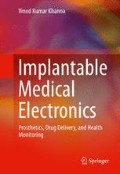Abstract
Ever since the introduction of the first artificial pacemaker in 1932, pacemaker technology has advanced rapidly. The early pacemakers could not sense the electrogram. They were brainless devices which only paced the ventricles asynchronously. Subsequent advanced devices called demand mode pacemakers contained a sense amplifier. This amplifier measured the cardiac activity of the patient to evade competition of the actual rhythms of the heart with paced rhythms. Furthermore, single-, dual-, and biventricular pacemakers were launched. Single-chamber pacemakers (one lead) were used to set the pace of only chamber of the heart; this single chamber was usually the left ventricle. Dual-chamber pacemakers (two leads) could set the pace of two chambers of the heart. Biventricular pacemakers used three leads. One lead was placed in the right atrium. The other two leads lay inside the ventricles, one lead per ventricle. Another noteworthy feature is that the early devices were an assembly of discrete resistors, transistors, and capacitors wired together on printed circuit boards, whereas the new devices are highly complex and integrated microprocessor-based systems. They are essentially extremely small computers equipped with RAM and ROM facilities. The topical topologies of pacemakers are tremendously complicated. They include two parts: the analog part and the digital part. The analog portion comprises the sense amplifier and an output stage which performs the pacing. The digital portion consists of sections containing the microcontroller with associated circuitry and the storage memory with accessories. The pacemakers are capable of implementing diagnostic scrutiny of the received electrograms. They provide device programmability. Also, they offer adaptive rate pacing, i.e., they are able to change the paced rate in proportion to metabolic workloads using an accelerometer.
Access this chapter
Tax calculation will be finalised at checkout
Purchases are for personal use only
References
Bolz A (2012) Cardiac pacemaker systems. Handbook of medical technology. Springer, Berlin, pp 767–783
Martínez GA (2007) External pacemaker of diagnose and research, experience in military hospital center Mexico. Proceedings of the World Congress on Engineering and Computer Science (WCECS 2007), 24–26 October 2007, San Francisco, pp 12–15
Beyerbach DM. Pacemakers and implantable cardioverter-defibrillators. http://emedicine.medscape.com/article/162245-overview#aw2aab6b8. Accessed 13 Dec 2014
Bernstein AD, Daubert J-C, Fletcher RD et al (2002) The revised NASPE/BPEG generic code for antibradycardia, adaptive-rate, and multisite pacing. J Pacing Clin Electrophysiol 25(2):260–264
Love CJ (2006) Cardiac pacemakers and defibrillators, 2nd edn. Landes Bioscience, p 174
Wood MA, Ellenbogen KA (2002) Cardiac pacemakers from the patient’s perspective. Circulation 105:2136–2138
Rassin M, Zilcha L, Gross DA (2009) Pacemaker in my heart—classification of questions asked by pacemaker patients as a basis for intervention. J Clin Nurs 18(1):56–62
Aquilina O (2006) A brief history of cardiac pacing. Images Paediatr Cardiol 8(2):17–81
Woollons DJ (1995) To beat or not to beat: the history and development of heart pacemakers. Eng Sci Educ J 4(6):259–268
Furman S (2003) The early history of cardiac pacing. Pacing Clin Electrophysiol 26(10):2023–2032
Ridgely P, Forde M (2006) Ch 54: implantable cardiac pacemakers. In: Bronzino JD (ed) Medical devices and systems. CRC, Boca Raton, pp 54–1–54–12. doi:10.1201/9781420003864.ch54
Haddad SAP, Houben R, Serdijn WA (2003) An ultra low-power dynamic translinear cardiac sense amplifier for pacemakers. Proceedings of the IEEE International Symposium on Circuits and Systems, ISCAS’03 Bangkok, 25–28 May, 5, pp V-37–V-40
Sanders RS, Lee MT (1996) Implantable pacemakers. Proc IEEE 84(3):480–486
Haddad SAP, Serdijn, WA (2009) Ch2: The evolution of pacemakers: an electronics perspective. In: Ultra low-power biomedical signal processing: an analog wavelet filter approach for pacemakers, Springer Science + Business Media, pp 13–31
Hayes DL, Wang PJ, Reynolds DW et al (1997) Interference with cardiac pacemakers by cellular telephones. N Engl J Med 336:1473–1479
Woodruff J, Prudente LA (2005) Update on implantable pacemakers. J Cardiovasc Nurs 20(4):261–268
Soontornpipit P (2012) An implantable biotelemetry review: technology for a cardiac pacemaker device. Asia J Publ Health 3(3):111–120
Mittal T (2005) Pacemakers—a journey through the years. Ind J Thor Cardiovasc Surg 21:236–249
Author information
Authors and Affiliations
Rights and permissions
Copyright information
© 2016 Springer International Publishing Switzerland
About this chapter
Cite this chapter
Khanna, V.K. (2016). Cardiac Pacemakers. In: Implantable Medical Electronics. Springer, Cham. https://doi.org/10.1007/978-3-319-25448-7_14
Download citation
DOI: https://doi.org/10.1007/978-3-319-25448-7_14
Published:
Publisher Name: Springer, Cham
Print ISBN: 978-3-319-25446-3
Online ISBN: 978-3-319-25448-7
eBook Packages: EngineeringEngineering (R0)

